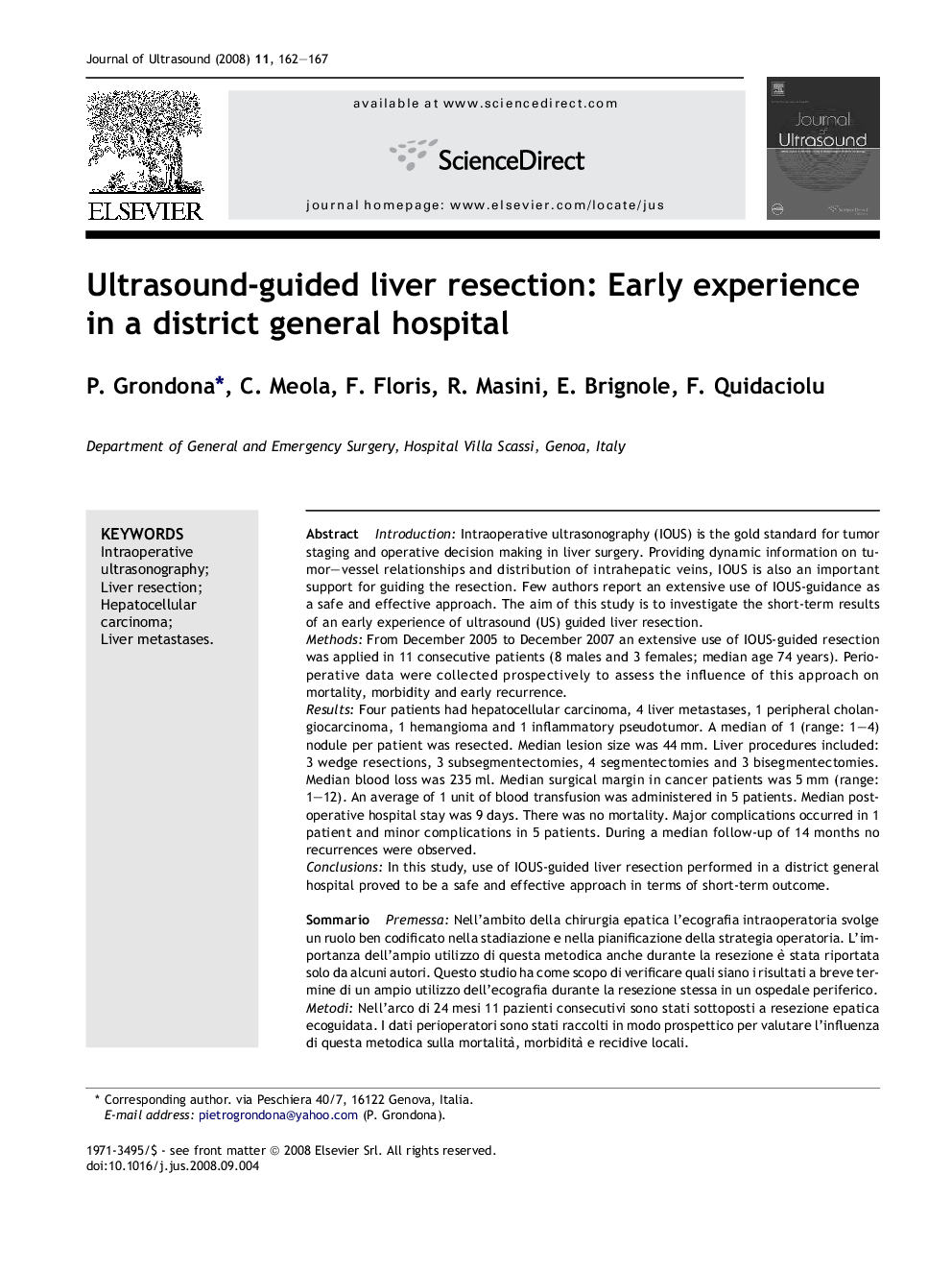| Article ID | Journal | Published Year | Pages | File Type |
|---|---|---|---|---|
| 4236933 | Journal of Ultrasound | 2008 | 6 Pages |
IntroductionIntraoperative ultrasonography (IOUS) is the gold standard for tumor staging and operative decision making in liver surgery. Providing dynamic information on tumor–vessel relationships and distribution of intrahepatic veins, IOUS is also an important support for guiding the resection. Few authors report an extensive use of IOUS-guidance as a safe and effective approach. The aim of this study is to investigate the short-term results of an early experience of ultrasound (US) guided liver resection.MethodsFrom December 2005 to December 2007 an extensive use of IOUS-guided resection was applied in 11 consecutive patients (8 males and 3 females; median age 74 years). Perioperative data were collected prospectively to assess the influence of this approach on mortality, morbidity and early recurrence.ResultsFour patients had hepatocellular carcinoma, 4 liver metastases, 1 peripheral cholangiocarcinoma, 1 hemangioma and 1 inflammatory pseudotumor. A median of 1 (range: 1–4) nodule per patient was resected. Median lesion size was 44 mm. Liver procedures included: 3 wedge resections, 3 subsegmentectomies, 4 segmentectomies and 3 bisegmentectomies. Median blood loss was 235 ml. Median surgical margin in cancer patients was 5 mm (range: 1–12). An average of 1 unit of blood transfusion was administered in 5 patients. Median postoperative hospital stay was 9 days. There was no mortality. Major complications occurred in 1 patient and minor complications in 5 patients. During a median follow-up of 14 months no recurrences were observed.ConclusionsIn this study, use of IOUS-guided liver resection performed in a district general hospital proved to be a safe and effective approach in terms of short-term outcome.
SommarioPremessaNell'ambito della chirurgia epatica l'ecografia intraoperatoria svolge un ruolo ben codificato nella stadiazione e nella pianificazione della strategia operatoria. L'importanza dell'ampio utilizzo di questa metodica anche durante la resezione è stata riportata solo da alcuni autori. Questo studio ha come scopo di verificare quali siano i risultati a breve termine di un ampio utilizzo dell'ecografia durante la resezione stessa in un ospedale periferico.MetodiNell'arco di 24 mesi 11 pazienti consecutivi sono stati sottoposti a resezione epatica ecoguidata. I dati perioperatori sono stati raccolti in modo prospettico per valutare l'influenza di questa metodica sulla mortalità, morbidità e recidive locali.RisultatiOtto pazienti erano maschi. Età mediana 74 anni. Quattro HCC, 4 metastasi, 1 colangiocarcinoma periferico, 1 emangioma, 1 pseudotumore infiammatorio. Sono state eseguite 3 resezioni a cuneo, 3 subsegmentectomie, 4 segmentectomie e 3 bisegmentectomie. La perdita ematica mediana è stata 235 ml. In caso di tumore il margine di exeresi mediano è stato 5 mm (range 1–12 mm). Cinque pazienti sono stati trasfusi con emazie concentrate con una mediana di 1 Unità. La degenza mediana è stata 9 giorni, la mortalità zero. Complicanze maggiori e minori sono insorte rispettivamente in 1 e 5 pazienti. Durante un periodo di osservazione mediano di 14 mesi non si sono verificate recidive.ConclusioniNell'esperienza iniziale di un ospedale periferico, l'utilizzo della guida ecografica durante la resezione epatica si è rivelata sicura ed efficace a breve termine.
